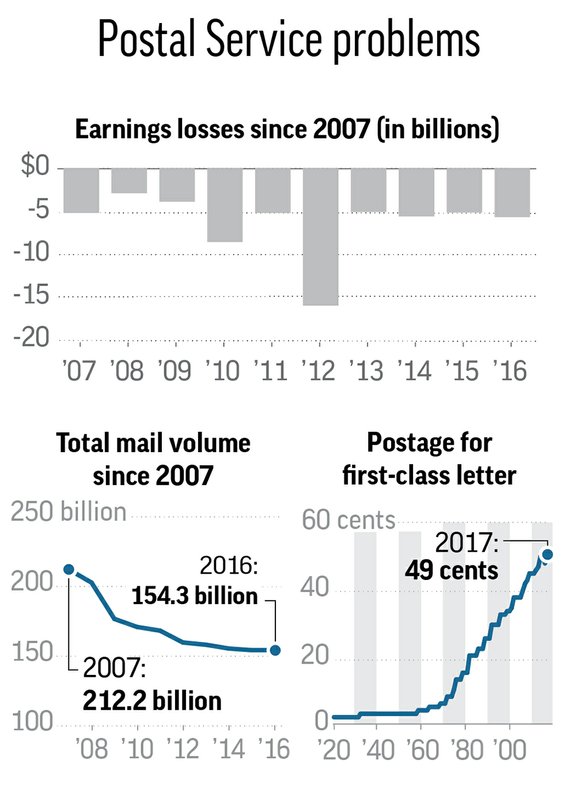WASHINGTON (AP) — A 60 cent postage stamp?
The U.S. Postal Service would have to boost prices for mailing letters and packages by nearly 20 percent — the biggest one-time increase in its history — to avoid bankruptcy and improve delivery service, an industry analysis says.
That means the price of a first-class stamp could jump from 49 cents to nearly 60 cents — if the post office gets the power to raise stamp rates beyond the rate of inflation.
The Postal Service is currently petitioning the agency that oversees it, the Postal Regulatory Commission, to grant the biggest change to its pricing system in a half century: the authority to lift a cap on postal rates. The commission’s decision is expected within weeks.

If the Postal Service gets the ability to raise rates, it could add substantially to the cost of mailing prescription drugs and magazines, for example. Packaging and bulk-mail rates also would be affected, straining tight budgets for an increasing number of state and local governments that distribute election ballots by mail.
Colorado, Oregon and Washington conduct elections almost entirely by mail, while California is making the switch and will fully do so beginning with the 2020 elections. Most other states also mail out ballots as a part of early voting. Ballots are typically distributed via bulk mail and returned by voters with first-class postage.
“We would be concerned about any change that would impact a voter’s ability to get their mail ballots in,” said Amber McReynolds, the director of elections for the city and county of Denver. Her county is among several jurisdictions that cover the expense if voters don’t affix enough postage.
The Postal Service did not dispute the industry’s analysis, which was conducted for the Coalition for a 21st Century Postal Service, a broad trade group that includes mailers from Amazon to the Greeting Card Association and National Retail Federation.
Trade groups already anticipate lawsuits to block any decision that grants the post office pricing freedom.
“Americans will see devastating increases in postage rates that will do grave damage to magazines, subscribers and the countless charities that rely on the mail to fulfill their missions,” said Linda Thomas Brooks, president and chief executive officer of MPA-The Association of Magazine Media.
Art Sackler, manager of the Coalition for a 21st Century Postal Service, said several mailers have expressed concerns about the commission’s legal authority to lift the rate cap on postal rates, saying that Congress never intended the Postal Service to have such wide flexibility. In previous cases where the Postal Service has sought special exemptions to raise rates beyond inflation, mailers have sued to block the move.
“For something this big and controversial, there’s no doubt we’ll see a legal review,” he said.
Wendy Underhill, director for elections and redistricting at the National Conference of State Legislatures, said additional costs in mailing ballots would be a problem even though many states and counties also allow voters to drop off ballots at polling sites. Legislatures in California, New York and Washington have been wrestling over whether they should pay for return postage as part of a growing trend of vote by mail, sensitive to complaints that the added cost to voters might be criticized as a “poll tax.”
“Any government service has costs associated with them, so when the price of poll workers or postage goes up, so do the cost of running elections,” she said.
The Postal Service is pointing a finger of blame partly at Congress for its financial troubles, noting declining use of mail but also onerous retiree health benefit costs. Legislation passed in 2006 required the Postal Service to prefund 75 years’ worth of retiree health benefits, something that no other government or private business is required to do.
A bipartisan bill passed by a House committee earlier this year would ease much of the Postal Service’s problems caused by that health benefits requirement, helping avoid significant price increases. But the legislation has been stalled by a separate review in the House Ways and Means Committee, which is seeking to focus first on overhauling the nation’s tax code.
Congress also could give the Postal Service the pricing flexibility it says it needs, but the House bill currently allows only a one-cent increase.
The chairman of the Postal Regulatory Commission, Robert Taub, told The Associated Press last month that commissioners could not wait and assume that lawmakers will eventually pass legislation to address Postal Service problems.
If Congress doesn’t act soon, “then much more intense pressure will be brought to bear” on price increases, the Postal Service said in a statement.
The industry analysis found the Postal Service would have to raise rates by 17.6 percent for letters and packages to cover billions in current losses. When including a planned $6 billion overhaul of the post office’s 30-year-old truck fleet, the amount of rate increase required would be nearly 19 percent, or more than 9 cents, for a first-class stamp.
That one-time increase would not include hikes due to inflation. Trade groups already anticipate the Postal Service will propose a penny increase early next year based on the consumer price index.
___
On Twitter, follow Hope Yen at
WHAT OTHERS ARE CLICKING ON:
- OBAMA CALLS DECISION TO PHASE-OUT DACA ‘CRUEL’
- SURVEILLANCE VIDEO: TAKE-OVER ROBBERY AT TARGET
- MOTHER ACCUSED OF ENCOURAGING 4-YEAR-OLD TO FIGHT
- DEPUTIES CHARGED FOR LETTING INMATES THROW FECES
- BOY, 15, ARRESTED IN CONNECTION WITH TRACY MURDER
- HOW TO HELP VICTIMS OF HURRICANE HARVEY